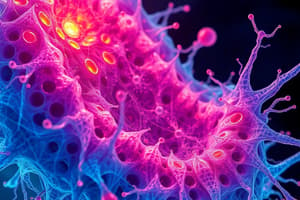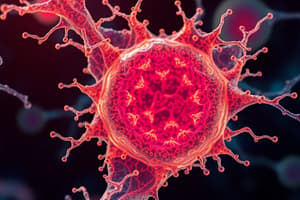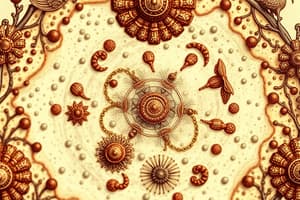Podcast
Questions and Answers
What structural feature primarily distinguishes eukaryotic cells from prokaryotic cells?
What structural feature primarily distinguishes eukaryotic cells from prokaryotic cells?
- Presence of ribosomes
- Unicellular organization
- Cell wall structure
- Nucleus enclosed by a membrane (correct)
In prokaryotic cells, where is the DNA located?
In prokaryotic cells, where is the DNA located?
- In the nucleus
- In the cytoplasm along with ribosomes (correct)
- Surrounded by a membrane
- In the plasma membrane
What is the primary function of the cell wall in prokaryotic cells?
What is the primary function of the cell wall in prokaryotic cells?
- Replication of DNA
- Synthesis of proteins
- Energy production
- Structural support and barrier protection (correct)
Which of the following best describes the DNA in eukaryotic cells?
Which of the following best describes the DNA in eukaryotic cells?
Which characteristic is common to both prokaryotic and eukaryotic cells?
Which characteristic is common to both prokaryotic and eukaryotic cells?
Who was the first to use the term 'cell'?
Who was the first to use the term 'cell'?
What did the German doctor Rudolf Virchow propose about cells?
What did the German doctor Rudolf Virchow propose about cells?
What is NOT one of the three main points of the cell theory?
What is NOT one of the three main points of the cell theory?
Why are cells small in size?
Why are cells small in size?
Which scientist is NOT associated with the development of the cell theory?
Which scientist is NOT associated with the development of the cell theory?
What is the primary component of the plant cell wall that provides structural support?
What is the primary component of the plant cell wall that provides structural support?
What percentage of a mature plant cell's volume can the central vacuole occupy?
What percentage of a mature plant cell's volume can the central vacuole occupy?
Which function is NOT attributed to the central vacuole?
Which function is NOT attributed to the central vacuole?
What organelle in plant cells captures light energy to produce sugars?
What organelle in plant cells captures light energy to produce sugars?
What is the fluid contained within chloroplasts called?
What is the fluid contained within chloroplasts called?
What is the primary role of lysosomes in a cell?
What is the primary role of lysosomes in a cell?
Which organelle is formed by the Golgi apparatus and contains enzymes for digestion?
Which organelle is formed by the Golgi apparatus and contains enzymes for digestion?
What is the structural composition of centrioles?
What is the structural composition of centrioles?
Which function is NOT commonly associated with vacuoles?
Which function is NOT commonly associated with vacuoles?
What is the main function of the cytoskeleton in a cell?
What is the main function of the cytoskeleton in a cell?
Flashcards are hidden until you start studying
Study Notes
Cell Discovery and Theory
- The term "cell" was first introduced by Robert Hooke in 1665 after observing cork slices under a microscope, comparing the structure to a honeycomb.
- Antony van Leeuwenhoek advanced microscopy in the 1670s, observing various microbes and body cells.
- By the early 19th century, it was proposed that all living organisms are composed of cells, culminating in the cell theory established by Theodor Schwann and Matthias Jakob Schleiden in 1839.
- Rudolf Virchow added to the cell theory in 1858, stating that all cells arise from pre-existing cells.
Cell Theory Components
- All organisms consist of one or more cells, where vital life processes occur.
- Cells are the smallest living units and basic organizational units of life.
- New cells arise only by the division of existing cells.
Size and Function of Cells
- Cells are typically very small to facilitate efficient absorption of nutrients and gases.
- Size limitations are necessary for rapid nutrient transfer and waste elimination, preventing excess growth.
Prokaryotic Cells
- Prokaryotes are unicellular organisms, most characterized by a simple structure without membrane-bound organelles.
- They contain ribosomes, with metabolic functions occurring mostly at the plasma membrane, and often have a cell wall for structure and protection.
- Prokaryotic DNA is circular and located in the cytoplasm; most prokaryotes are between 1–10 μm in diameter, thriving in diverse environments.
Eukaryotic Cells
- Eukaryotes feature complex cell structures organized by internal membranes and a cytoskeleton, with a definitive nucleus housing DNA.
- Their DNA is linear, organized into chromosomes; eukaryotes can be unicellular or multicellular.
Cell Structure and Plasma Membrane
- Cells vary in type and function, maintaining homeostasis through unique structural features.
- The plasma membrane separates the cell's internal environment from the outside and demonstrates selective permeability.
- It is composed of a phospholipid bilayer, with polar heads facing outward and hydrophobic tails inward.
Membrane Permeability and Transport
- The plasma membrane allows small, nonpolar molecules (e.g., O2, CO2) to pass freely, while larger or charged molecules require specific transport mechanisms.
- Endocytosis is the process for cellular intake of materials, while exocytosis is for material release.
- Pinocytosis refers to the uptake of liquid, and phagocytosis involves ingesting large solid particles.
Cytoplasm
- Cytoplasm is a gel-like substance containing organelles, playing a critical role in maintaining cell structure and shape due to its pressure against the plasma membrane.
Nucleus and Genetic Material
- The nucleus, the largest organelle in eukaryotic cells, holds the majority of genetic material encoded in DNA.
- It is surrounded by a nuclear envelope, separating its contents from the cytoplasm.
Unique Plant Cell Structures
- Plant cells possess distinct features not found in animal cells, such as a cell wall, large central vacuole, and plastids like chloroplasts.
- The cell wall, made of cellulose, provides structural support and protection while allowing nutrient exchange.
- The central vacuole plays roles in storage and maintaining turgor pressure within the cell.
- Chloroplasts facilitate photosynthesis by converting solar energy into food using water and carbon dioxide, containing their own DNA.
Golgi Apparatus
- Located near the nucleus, it modifies proteins from the rough endoplasmic reticulum (RER).
- Involved in lipid transport within the cell.
Vesicles
- Small, spherical compartments formed by lipid bilayers, often originating from the Golgi apparatus or the endoplasmic reticulum.
- Essential for organizing metabolism, transporting, and storing molecules.
- Can be reaction chambers and classified based on contents and functions.
Lysosome
- Type of vesicle formed in the Golgi apparatus, containing enzymes for digestion.
- Breaks down harmful cell products, waste, and cellular debris, expelling them from the cell.
- Destroys invading organisms such as bacteria and digests cells that are ready to die.
Centrioles
- Rod-like structures composed of short microtubules arranged in nine triplets.
- Two centrioles positioned perpendicularly form a centrosome.
- Crucial for cellular division; absent in plant cells.
Vacuoles
- Membrane-bound organelles with roles in secretion, excretion, and storage.
- Serve as storage areas in various organisms; plant cells often have large vacuoles.
Cytoskeleton
- Composed of tiny protein filaments and tubules, providing structural framework within the cytoplasm.
- Includes three types: microfilaments, intermediate filaments, and microtubules.
Special Structures in Plant Cells
- Plant cells have unique features such as cell walls, large central vacuoles, and plastids like chloroplasts.
Cell Wall
- A rigid structure made of cellulose, located outside the cell membrane.
- Provides protection and structural support; allows movement of water and nutrients.
Central Vacuole
- Occupies a significant volume in mature plant cells (30%-90%).
- Surrounded by the tonoplast membrane; primarily functions in storage and maintaining turgor pressure.
Chloroplast
- Organelle responsible for photosynthesis, capturing light energy to produce food (sugar) from water and carbon dioxide.
- Enclosed by double membranes; contains stroma with circular DNA.
Transport Mechanisms
- Specific transport mechanisms are needed for substances like glucose, ions, and proteins to cross the cell membrane.
- Integral membrane proteins assist in transporting these substances via pumping or channels.
Cellular Processes
- Endocytosis: Uptake of molecules and solids across the cell membrane into the interior.
- Exocytosis: Release of materials from the cell cytoplasm through the cell membrane.
- Pinocytosis: Ingestion of small extracellular fluids.
- Phagocytosis: Ingestion of large particles like bacteria and cellular debris.
Cytoplasm
- Gel-like substance holding organelles, providing shape and support.
- Composed mainly of 80%-90% water, exerting pressure against the plasma membrane.
Nucleus
- Largest organelle in eukaryotic cells, containing most of the cell's genetic information encoded in DNA.
- Enclosed by a nuclear envelope (double membrane) separating its contents from the cytoplasm.
Studying That Suits You
Use AI to generate personalized quizzes and flashcards to suit your learning preferences.




